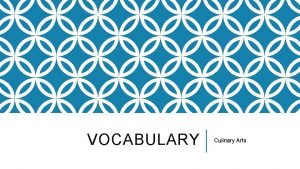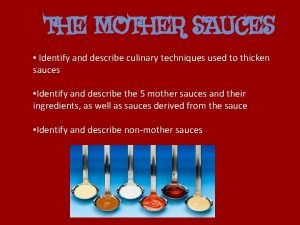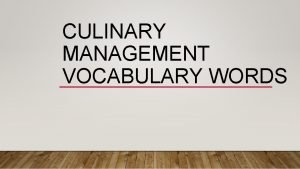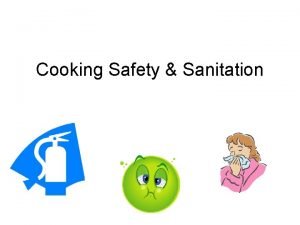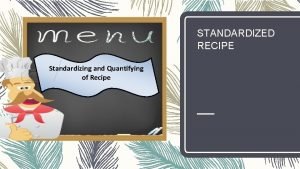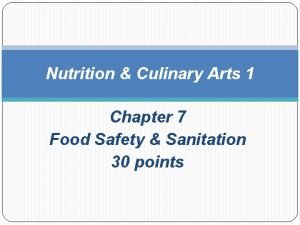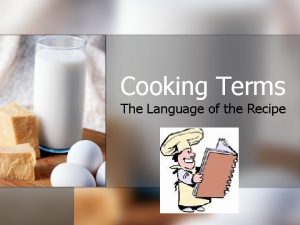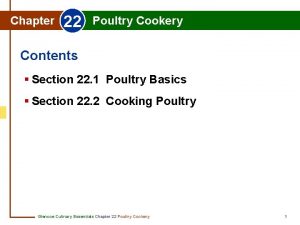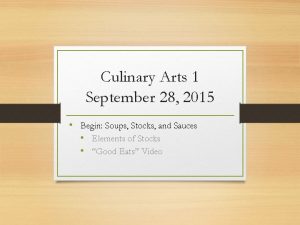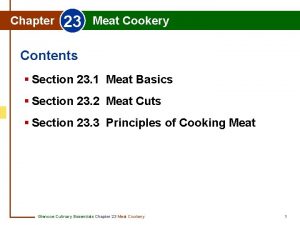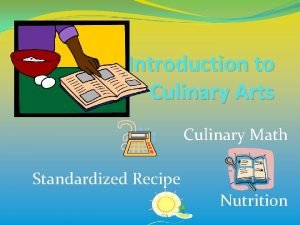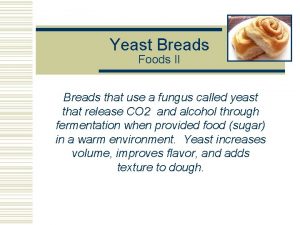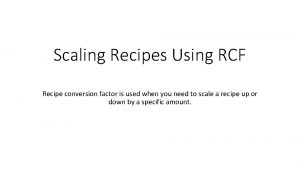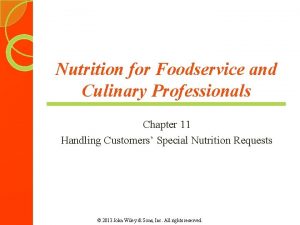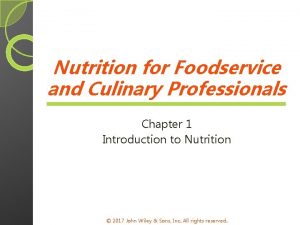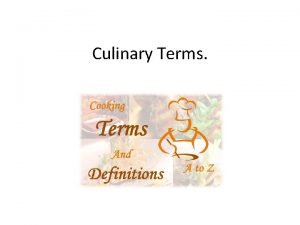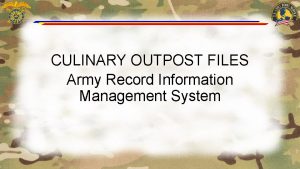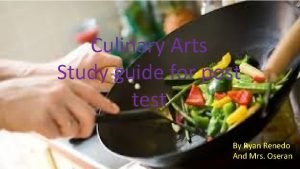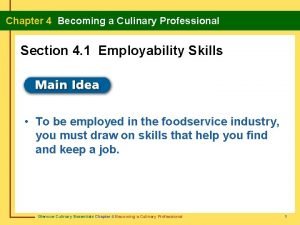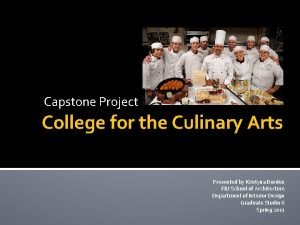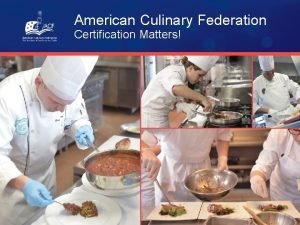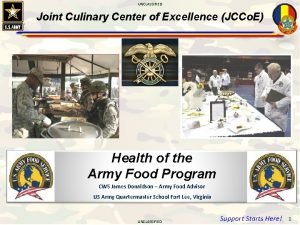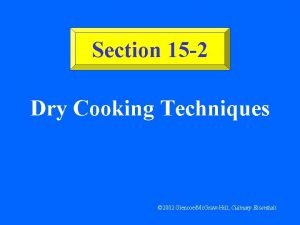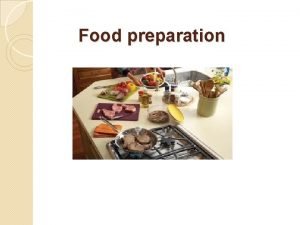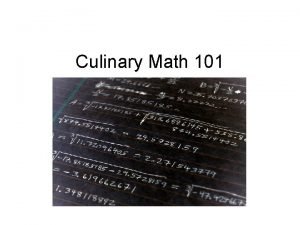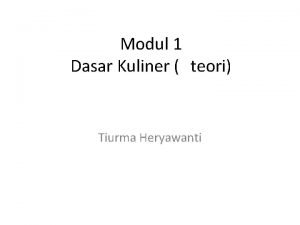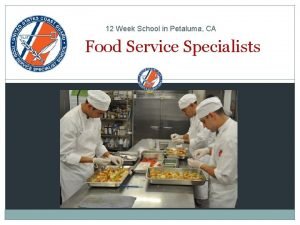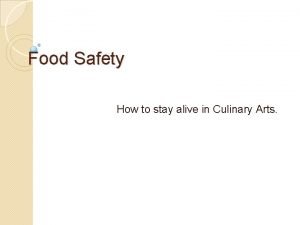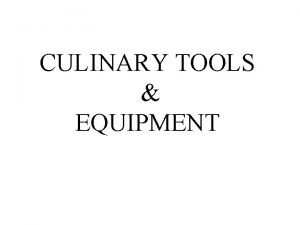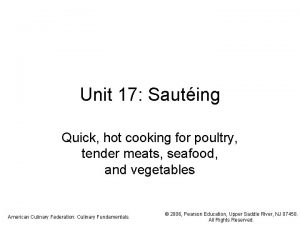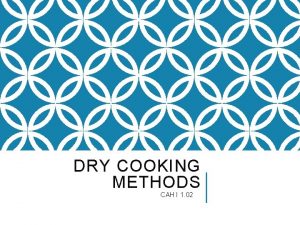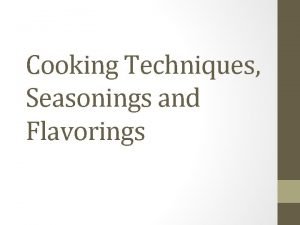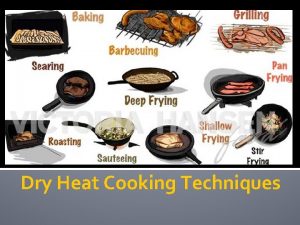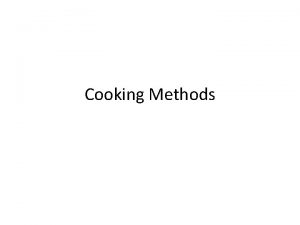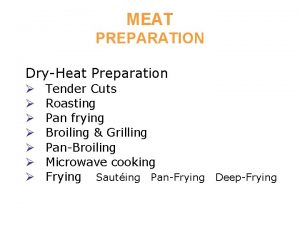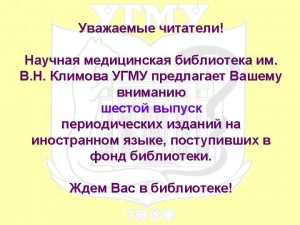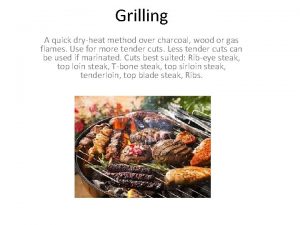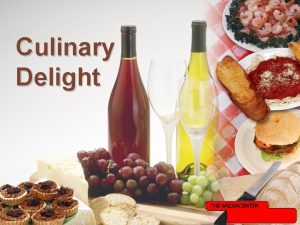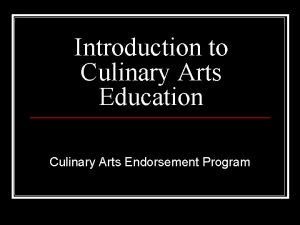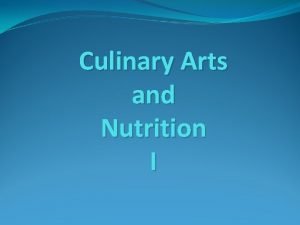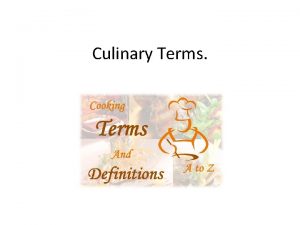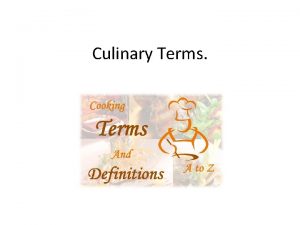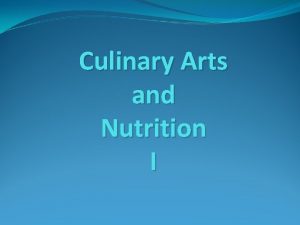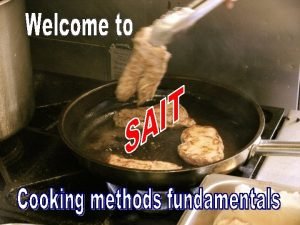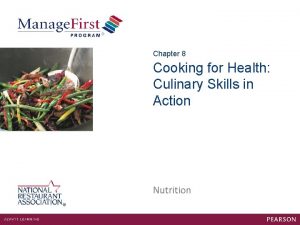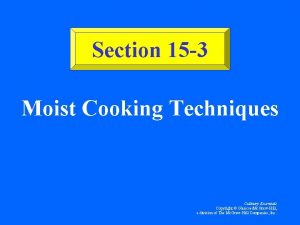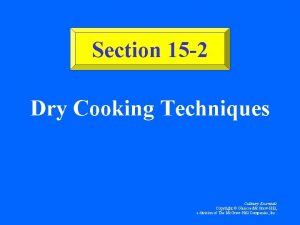CULINARY DRYHEAT COOKING I SAUTING Definition Cooking in





































- Slides: 37

CULINARY: DRY-HEAT COOKING I

SAUTÉING Definition: Cooking in a small amount of fat at a high temperature Food must be naturally tender

SAUTÉING: FOOD SELECTION Items to be sautéed should be: Tender Portion-sized Cooked or small pieces to order

TYPES OF FOOD SUITABLE FOR SAUTÉING Beef, veal, pork, poultry, and game Seafood High-moisture Precooked vegetables and potatoes

APPROPRIATE OILS AND FATS FOR SAUTÉING Stable fats suitable for high temperature Small amounts of fat are used Examples include: Clarified butter Neutral-flavored Rendered fats oil

LIQUIDS FOR DEGLAZING Wine Stock Cognac or liqueur Fortified wine Water

SAUTÉING SAUCE Liquid base for the sauce Jus lié of the appropriate flavor Meat glaze Vegetable coulis or purée

SAUTÉING OPTIONAL COMPONENTS Aromatics Finishing to flavor the sauce ingredients Garnishing ingredients

SAUTÉING EQUIPMENT Pan selection Sautéuse Sautoir Select the proper pan size

SAUTÉING PROCEDURES Prepare food items for sautéing Sear items Finish larger items on stove top Remove items from the pan and reserve Degrease the pan Deglaze with liquid Form sauce Plate or pan and serve sauce over the main item

NUTRITIONAL INFORMATION FOR SAUTÉING FOOD Use a well-seasoned or nonstick pan; no fat needed Use salt herbs and spices to reduce the amount of Serve with light, flavorful sauces Use low-fat/low-calorie liquids to deglaze Use arrowroot or cornstarch to thicken sauce

PAN-FRYING Definition: Cooking method where food items are partially submerged in fat or oil Items are usually coated with breading or batter Amount of fat used should cover the bottom 1/4 to 1/3 of the product Pan-fried items can be completely cooked during the frying process or finished in an oven

PAN-FRYING FOOD SELECTION Items to be cooked by pan-frying are: Tender Portion smaller size or

SUITABLE FOOD ITEMS FOR PANFRYING Veal Chicken Pork Seafood Vegetables/starches Pre-prepared items

PAN-FRYING INGREDIENTS Standard breading mise en place Product Flour Egg wash Breading agent Pan for finished product

PAN-FRYING: OILS AND FATS Cooking medium Fat or oil should be able to reach a high temperature without breaking down or smoking Appropriate fat and oil Clarified butter Neutral-flavored oil Canola oil Rendered fat

PAN-FRYING OPTIONAL COMPONENTS Filling Stuffing

PAN-FRYING EQUIPMENT Tong, kitchen fork, skimmer, and spider Holding or finishing pans Station for blotting or draining items after frying Heated plates Sautoir

PAN-FRYING EQUIPMENT—CONTINUED Select a sautoir of an appropriate size Cooking medium should come 1/4 to 1/3 up the sides of the food Pan and cooking medium have reached the proper temperature when a faint haze is noticeable

PAN-FRYING PROCEDURES Heat oil to appropriate temperature Add main item to pan in a single layer Fry food on the first side until golden brown Turn item and cook to desired doneness Remove item and finish in an oven, if necessary Drain item on absorbent paper Season and serve with appropriate sauce/garnish

ADDITIONAL PAN-FRYING INFORMATION Fat should be correct amount and proper temperature Items should be cooked as close to serving time as possible Separate Fat sauces typically are used laden with burned food particles should be discarded

PAN-FRYING: THINGS NOT TO DO Don’t cook items ahead and hold Don’t deglaze the pan to make a sauce

DEEP-FRYING Definition: Cooking method where food items are completely submerged in hot fat or oil Food item is almost always given a protective coating Items should be completely cooked when removed from fryer

DEEP-FRYING METHODS Two major methods of deep-frying Basket method Swimming method Method used is dependent on size of product and type of coating

DEEP-FRYING FOOD SELECTION Items to be deep-fried should be: Tender In small pieces that can be completely cooked by the time the coating achieves the proper browning

FOOD ITEMS SUITABLE FOR DEEPFRYING Vegetables White meat or poultry Seafood Potatoes Cheeses

DEEP-FRYING: TYPES OF COATING Standard breading Tempura Française: Flour Anglaise: Flour, egg wash, and bread crumbs Batters: Plain or beer

DEEP-FRYING: BREADING Product to be breaded Flour Egg wash Breading Finished product

DEEP-FRYING: BATTER Product to be battered Flour Batter Deep-fat fryer Finished product

DEEP-FRYING: OIL AND FAT Should be able to reach a high temperature without breaking down Neutral-flavored Rendered oil fat such as lard

ENEMIES OF DEEP-FRYING FAT High temperature and prolonged heating Free fatty acids Moisture Exposure to air Certain metals Salt Food particles

INDICATORS THAT FRYING FAT NEEDS CHANGING Low smoking point Foaming Color of product is off, darkens quickly Product absorbs excess fat Product cooks too slowly Resin forms on top Flavor of product changes Unpleasant odor

DEEP-FRYING OPTIONAL COMPONENTS Stuffing Sauce

DEEP-FRYING EQUIPMENT Thermostat-controlled deep-fat fryer Skimmer Draining rack and absorbent paper

DEEP-FRYING PROCEDURES Heat fat to the proper temperature Coat products with desired coating Add main item to the hot fat Turn items during frying, if necessary Remove Blot main item and finish in oven, if necessary food with absorbent paper towel Season and serve with appropriate sauce and garnish

DEEP-FRYING PROCEDURES—CONTINUED Fat must be hot or food will absorb excess grease Fat should be skimmed frequently Fat should be strained daily Type of fat used will influence flavor of food Turn down heat when fryer is not in heavy use Cover fryer when not in use and keep clean

DEEP-FRYING: THINGS NOT TO DO Don’t salt food over fryer Don’t overload baskets with food items Don’t fry uncoated meat such as bacon or sausage Don’t use fat that has broken down or is excessively dark
 International cooking a culinary journey
International cooking a culinary journey Slurry culinary definition
Slurry culinary definition Mother sauces culinary definition
Mother sauces culinary definition Intermezzo salad definition
Intermezzo salad definition Fat tom culinary definition
Fat tom culinary definition What is a standardized recipe
What is a standardized recipe Culinary nutrition definition
Culinary nutrition definition To mix foods lightly with a lifting motion
To mix foods lightly with a lifting motion Crosshatch marks culinary definition
Crosshatch marks culinary definition Degrease culinary definition
Degrease culinary definition Barding meat
Barding meat 6 parts of a standardized recipe
6 parts of a standardized recipe Yeast culinary definition
Yeast culinary definition Chef culinary conference
Chef culinary conference Rcf cooking
Rcf cooking Chapter 11 culinary nutrition
Chapter 11 culinary nutrition Nutrition for foodservice and culinary professionals
Nutrition for foodservice and culinary professionals Los angeles harbor city college
Los angeles harbor city college Culinary words
Culinary words Arims user guide
Arims user guide Culinary arts study guide
Culinary arts study guide Culinary jeopardy
Culinary jeopardy Chapter 4 becoming a culinary professional answers
Chapter 4 becoming a culinary professional answers Culinary capstone project ideas
Culinary capstone project ideas Acf certification
Acf certification Joint culinary center of excellence
Joint culinary center of excellence Section 15-2 dry cooking techniques
Section 15-2 dry cooking techniques Another definition of
Another definition of Culinary crossword 2.1 fire safety answers
Culinary crossword 2.1 fire safety answers Culinary math
Culinary math What is the white part of an egg called
What is the white part of an egg called Pengertian culinary
Pengertian culinary Culinary school in thailand for international students
Culinary school in thailand for international students Coast guard culinary school
Coast guard culinary school What is fattom
What is fattom Culinary
Culinary Caravan on the move
Caravan on the move Nutrition for foodservice and culinary professionals
Nutrition for foodservice and culinary professionals

